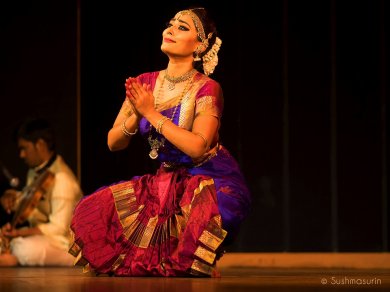
|   |

|   |
An evening soaked in bhakti - Shilpi Aggarwal e-mail: editor.diplomaticvibes@gmail.com February 9, 2018 One saw a dancer soaked in bhakti at the Bharatanatyam recital of Kiranmayee Madupu, disciple of Guru Hemamalini Arni, at India Habitat Centre in New Delhi on January 16, 2018. Kiranmayee showed thorough involvement in her dance. She had great restraint and the bhakti bhava that she maintained, devoid of any lasya throughout the recital, made her dance simply divine.  In her presentation ‘Sahityanjali’, Kiranmayee offered salutation to musical maestros of five Indian languages (Sanskrit, Kannada, Telugu, Tamil and Marathi) who have been a catalyst in the field of music with their astounding compositions. The recital began with a popular composition of Shyama Shastry, “Shankari Shamkuru” (ragam Saveri and talam tisra adi) which was sung in Sanskrit in praise of goddess Parvati. In this piece, Kiranmayee brought alive the various attributes of the goddess through her fine execution of jathis, crisp footwork and expressive abhinaya. Imagery of the goddess that she evoked through her dance with ease and dexterity was commendable. In the next piece, she presented a complex Pancharatna kriti of poet saint Thyagaraja, “Sadhinchane O Manasa” in ragam Arabhi, in which he elaborates on various deeds performed by Rama and Krishna. She set the stage with her beautiful opening jathi “ta ti tam” and depicted the various facets of Lord Krishna’s life especially when he stole the clothes of gopikas, whose crying and begging him was beautifully executed. The interlude of cymbals in the charanam on the lines “samayaniki thagu mataladene” was melodious and rhythmic to the ears. The prevailing bhakti mood at the auditorium was further deepened in the composition of Gopalakrishna Bharati, “Varugalamo Ayya.” Kiranmayee managed to bring out the sthayi bhava of this composition, humility and earnestness with conviction. She perfectly captured the wretchedness of Nandanar in her abhinaya and depicted the class-conflict of those times. A heart wrenching devotion and complete surrender to the deity in pallavi and anupallavi were quite touching. One could see tears in the performer’s eyes, enhanced with the pathos filled swaras. Kiranmayee’s virtuosity in dance was on full display in the often seen Purandara devaranama, “Jagadodharana adisidalu Yashoda” (Kapi, adi). She excelled in her depiction of Yashoda and vatsalaya bhakti bhava. The way she switched from scene to scene, giving us glimpses of the two parallel worlds - Yashoda’s world and the world that is owned and dominated by Lord Vishnu - was seamlessly interwoven. The details of Krishna’s childhood were etched with great sensitivity. The ending with a repetition of the word “Yashoda” where she kept herself engaged in making baby Krishna sleep long before music stopped showed her deep involvement in the performance. Kiranmayee concluded the evening with sixteenth century poet Tukaram’s abhang, “Pandhariche bhoot mothe” (Chandrakauns, adi). It was indeed a captivating performance by Hyderabad based Kiranmayee Madupu, elevated many notches by excellent vocal support by K. Chander Rao and brilliant nattuvangam by N.C. Raghunandan, especially at the end of the items. R. Kesavan’s mridangam and Raghavendra Prasath’s violin accompaniment enhanced the show. Shilpi Aggarwal is an ardent admirer of Indian classical dance forms. She runs her own tabloid on art, culture and travel, Bleisure, in Delhi. |